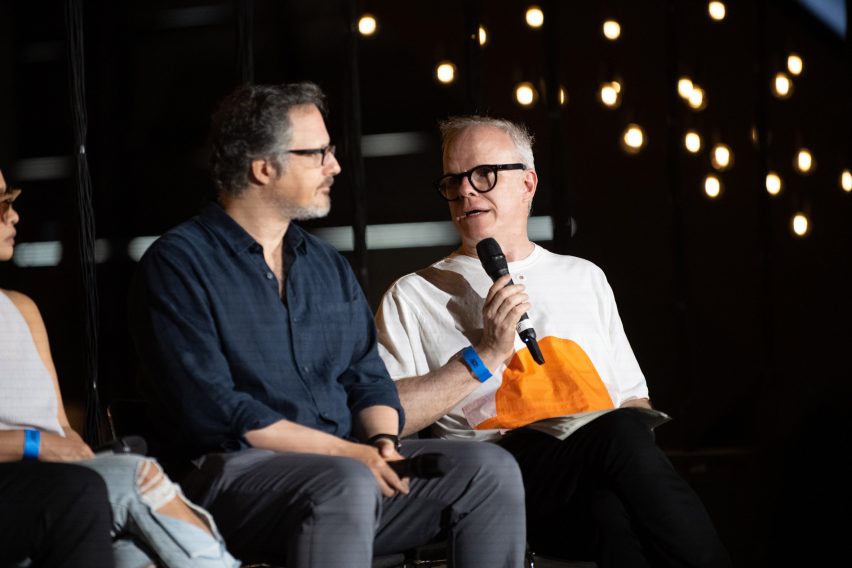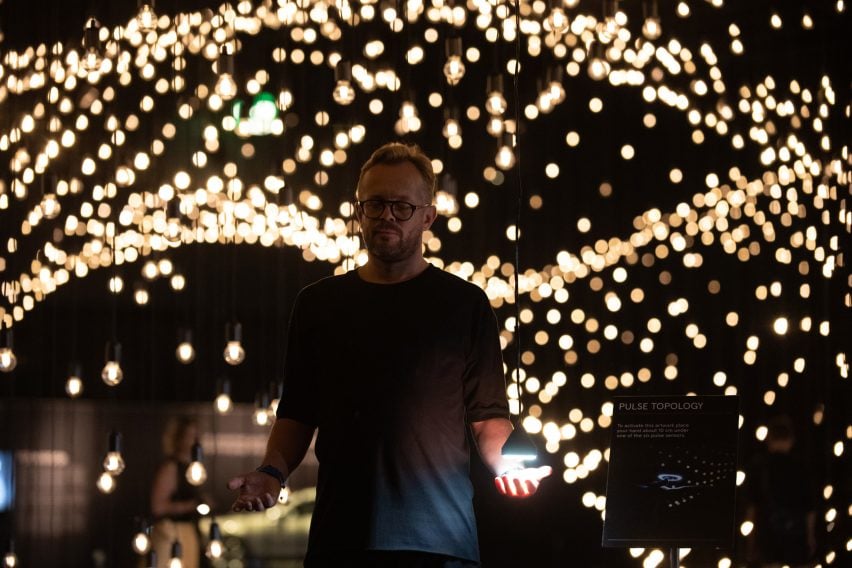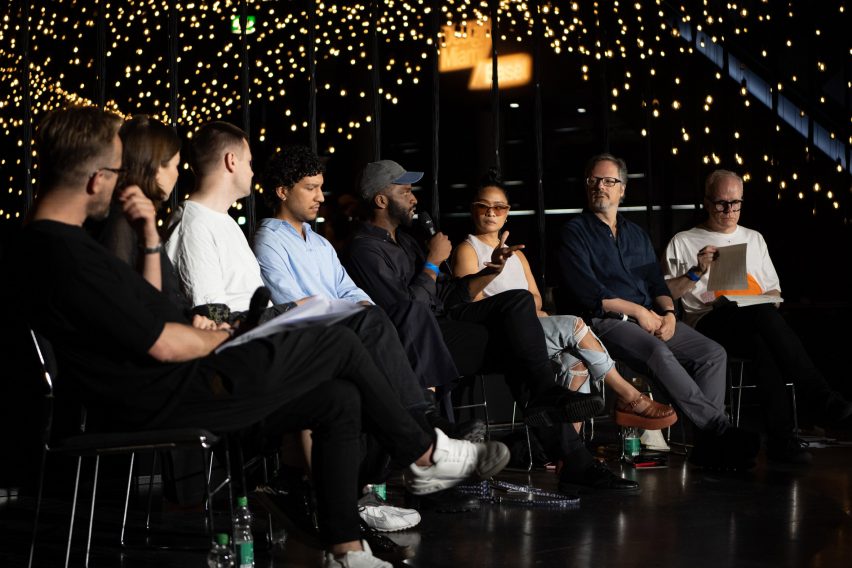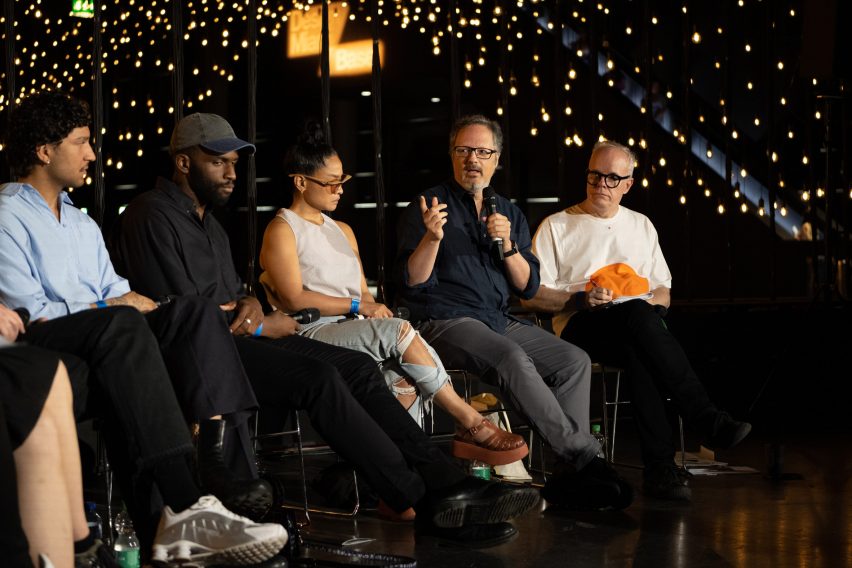Artists can use technology to create human connection say Therme Art panelists
Promotion: last month at Design Miami/Basel 2022, panelists at Therme Art's Wellbeing Culture Forum discussed how art, architecture and technology can combine to support mental and physical wellbeing.
Titled Invisible Symphonies: Healing Through Participatory Art and Human-Centred Technologies, the talk took place next to Rafael Lozano-Hemmer's immersive installation 'Pulse Topology' and used the artwork as a springboard for the conversation.
Opening at the annual Swiss art fair, the installation is a site-specific light and sound environment composed of an upside-down canopy of mountains and valleys made from thousands of suspended light bulbs.
The bulbs flicker on and off to mirror the pulse of visitors to the space, highlighting the heartbeat as a basic but essential biological element that is shared among us all.

The assembled panelists – artists Rafael Lozano-Hemmer, Brandon Ndife, James Bantone, Simon Denny, Stephanie Comilang and Sveta Mordovskaya – explored the spatial strategies that can be utilised within art, architecture, and technology to support mental and physical wellbeing.
The talk was chaired by Hans Ulrich Obrist, the Serpentine's artistic director, and Mikolaj Sekutowicz, CEO and co-founder of Therme Art.

Tatiana Kranz, co-founder of Yoga Futura opened proceedings with a guided meditation while Sekutowicz stood under the installation, allowing the artwork's heart-rate sensors to interact with his biometric data, resulting in an audiovisual experience displayed through the installation's 3,000 filament light bulbs.
"I think we are all humbled by the sound of the heartbeat as the very first sound that we hear in our mother's heartbeat," said Lozano-Hemmer. "Then we hear our own. And you know, when you're presenting a piece like this, to me, what matters is that you hear it in concert."
"The most important objective of art is for people to come together," he continued. "How do we create shared experiences that can generate a sense of community? This is an attempt to do that."

Discussing the way in which she uses technologies such as VR to create positive, emotional interactions in her work, artist and filmmaker Stephanie Comilang said, "The way that I use technology is I try and look at it as a tool for me to create more of a humanistic way of connection."
Talking about his work that fuses artificial and organic elements, Brandon Ndife commented: "The technology that a lot of people rely on is a service, a public service. So their technology is not actually owned by them."
"They might be contributing to it in the cycle of 'life in capitalism', but the technologies of life often are more like survival tactics," he continued. "And so when we think about a future or an alternative lifestyle, it has to be spearheaded by those in power already."
"Maybe it's also about considering what gets categorised as technological," offered Artist Simon Denny whose work makes visible the strategies and aesthetics of the technosphere. "Who gets to claim the technological and what is technology? And also, what is included in nature?"
"For me, as a good friend would say, the Internet is kind of like a portal to a different world of possibilities," commented James Bantone who explores contemporary meme and image-sharing culture in his work. "And it's very interesting because you can go very fast to a different world or galaxies and it's very exciting as well."

The talk took place as part of Therme Art's ongoing Wellbeing Culture Forum series in partnership with artistic enterprise Superblue.
Pulse Topology was presented by Superblue and supported by automobile brand BMW. The talk mirrored the recent projects by health initiative MYND, which have been developed by leading wellbeing provider Therme Group and neuroscience pioneer MindMaze. MYND supports artists in their exploration of mental health through research and the application of MindMaze's neurotechnology.
Therme Art's Wellbeing Culture Forum is a curated programme of discussions devised in response to the ongoing pandemic and the ensuing global crisis.
Therme Art is the creative arm of the Therme Group and is commissioning art and architecture to its spa baths and resorts around the world.
Through its Wellbeing Culture Forum programme of talks and panels, which has attracted thousands of viewers worldwide at large-scale events in Miami, London, Berlin, Venice and more, Therme Art aims to spark wellbeing-oriented innovation across all industries.
To learn more about Therme Art visit its website.
Partnership content
This article was written by Dezeen for Therme Art as part of a partnership. Find out more about Dezeen partnership content here.